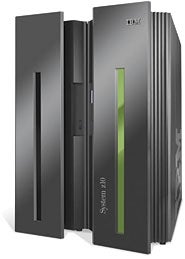NEW YORK — As enterprises struggle to contend with ballooning datacenter costs, IBM is banking that a more powerful, energy-friendly update of its z-series mainframe may be just the solution they need.
The company today showed off its new quad-core System z10, which it said delivers a 100 percent increase in performance along with a dramatic reduction in power consumption.
In unveiling the first new iteration in the z mainframe series since 2005, IBM executives gathered analysts and members of the press to introduce what it called a “commercial supercomputer,” built to address workload demands on datacenters that are increasing at an exponential rate.
[cob:Related_Articles]”We think that we’re at a fundamental inflection point in our industry in terms of the evolution of information technology,” said Steve Mills, senior vice president and group executive of software at IBM.
Amid escalating costs associated with power consumption, cooling and square footage, enterprises are finding that their datacenters cannot expand to support business development without a dramatic shift toward an agile virtualization environment.
“We are about to hit a wall,” said Rod Atkins, IBM’s senior vice president of technology development, citing a projected six-fold increase in server-center energy costs over the next few years.
Facing that energy crush, Atkins said that IBM was committed to doubling enterprise computing capacity by 2010 without increasing energy consumption or carbon footprint. To that end, the z10’s design stems from on Project Big Green, which IBM announced last May.
As a result, the 64-bit, quad-core mainframe is designed to provide enterprises with a more efficient datacenter solution, slashing energy costs and floor space requirements by up to 85 percent, IBM said.
The z10 is built to accommodate workloads from Linux, XML, Java, WebSphere and service-oriented architecture (SoA) implementations. IBM is also working with Sun and Sine Nomine Associates to integrate support for Open Solaris on z10.
 |
Big Blue’s “green” z10 mainframe Source: IBM |
“There’s not a commercial application out there that can’t run on z,” Mills said, heralding the z10 as “the world’s most powerful enterprise computing platform.”
IBM’s z10 runs four 4.4GHz processors — offering a performance comparable with nearly 1,500 x86 servers.
It’s also built to operate at up to 100 percent utilization, boasting a 70 percent capacity improvement over the z9, the company said.
With the new mainframe, IBM aims to expand into a request-driven server environment, with an operating system that anticipates an increased workload based on the ebb and flow of the business cycle and provisions resources accordingly.
IBM also added support for Cognos business intelligence (BI) reporting and analysis applications in the z10. Big Blue acquired the BI firm late last year.
Going forward, IBM plans to continue to incorporate iterative increases in capacity, speed and memory with future rollouts.
However, Mills said that today’s announcement of the z10 is particularly significant for its “wide-angle view” that supports non-mainframe applications.
“There is nothing about Web 2.0 that I can’t do inside of a ‘z’,” Mills said. “This thing runs like a bat out of hell.”
While seeking to meet datacenters’ growing needs for increased performance and energy-efficiency, z10 also marks a redoubling of Big Blue’s commitment to the mainframe model.
That effort comes as it faces increasing competition in the enterprise space from companies like Dell and Hewlett-Packard, who are promoting server networks.
Boasting the theoretical performance capacity of racks of x86 servers, the z10 is positioned as a way to simplify the IT work environment.
Whereas a distributed server environment typically requires additional infrastructure such as cable and networking switches, IBM promises a highly scalable, energy-efficient workhorse with the z10 — which it hopes will breathe new life into the decades-old mainframe concept.


